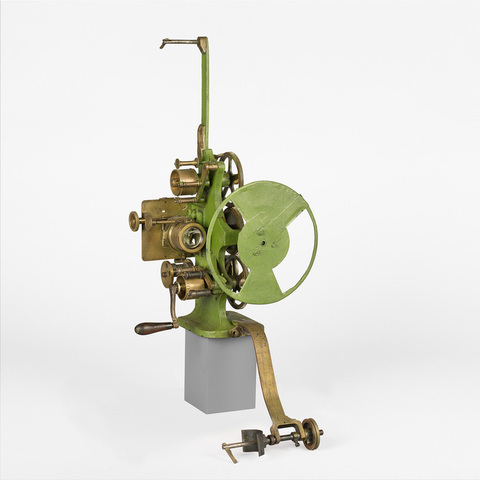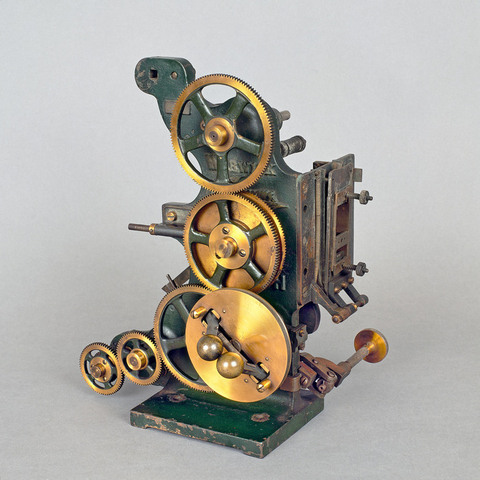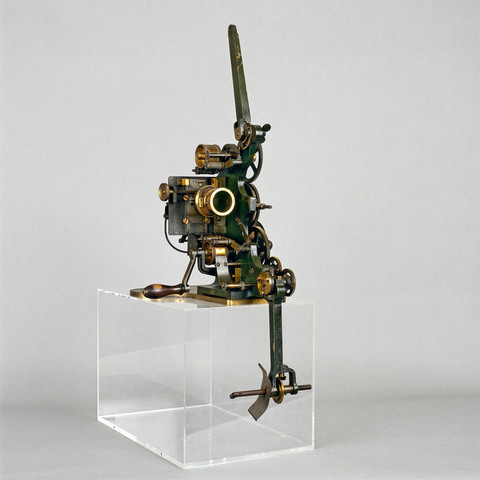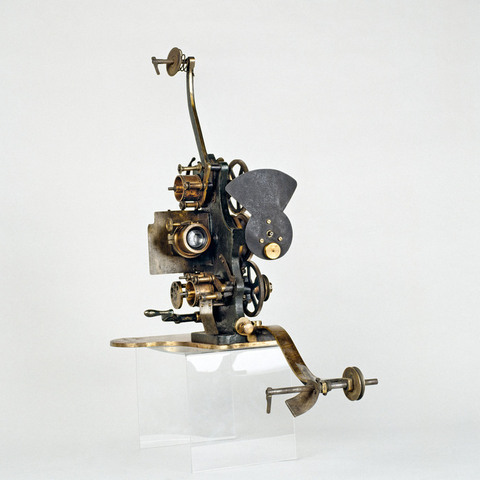Projecteur de film 35 mm
Fiche détaillée
Type de l'appareil
entraînement du film 35 mm par came battante ; deux débiteurs dentés ; obturateur deux pales ; bras débiteur et récepteur ; couloir presseur ; fenêtre réglable en descente et en montée
Auteurs
Beard Robert Royou
Londres, 10 Trafalgar Road, Old Kent Road
Fabricants
Robert Royou Beard
Londres, 10 Trafalgar Road, Old Kent Road
Charles Urban Trading Company
Londres, 48 Rupert Street
Utilisateurs
Beard Robert Royou
Londres, 10 Trafalgar Road, Old Kent Road
Distributeurs
Charles Urban Trading Company
Londres, 48 Rupert Street
Sujet du modèle
Informations non disponibles
Objectif
3 cm Ø
Taille de l'objet
Ouvert :
Informations non disponibles
Fermé :
Longueur : 24 cm
Largeur : 32 cm
Hauteur : 80 cm
Diamètre :
Informations non disponibles
Taille de la boîte de transport
Informations non disponibles
Remarques
Dépôt du Département de la Charente ville d'Angoulême, ex-collection René Charles n° 59 : "Projecteur 35 mm Urban Bioscope acquis par mes parents en 1938, tournée Forestier éqpoeu 1910-1914, environ de Chadurie, Charente".
"Appareil projecteur Urban Bioscope. Muni d'un objectif cylindrique (foyer au choix) et porte-objectif cuivre avec dispositif à pignon et crémaillère. Cet appareil est le même que celui employé dans les principaux théâtres et music-halls du monde entier, notamment à l'Alhambra et au Palace de Londres, au Jardin de Paris et à l'Alhambra de Paris. D'une solidité à toute épreuve et d'une fabrication spécialement soignée, cet appareil est de beaucoup supérieur à tous ceux présentés au public jusqu'à ce jour. Le cadre et les coussinets sont en acier fondu massif, émaillés vert à rinceaux d'or, les goupilles sont en acier fin et les roues dentées, supports de film, excentriques et porte-objectif, en cuivre massif et bronze, le tout fini à la main. [...] Les ressorts du cadre-presseur sont interchangeables. Tout appareil Urban est absolument garanti. Toutes ses parties sont rigoureusement vérifiées et assemblées de la façon la plus soigneuse, prix 700 fr." (Société générale des cinématographes Eclipse, Paris, s.d., p. 44).
"The Urban Bioscope Model H. Fiited with one cylindrical objective (any focus) and brass mount (for interchangeable lenses) with rack and pinion adjustment. Fully protected under Demeny Patent n° 24 457. Price with 1 lens (any focus) and mount, £ 17. This is the same type mechanism as used by the Alhambra, London, and by the principal Theatres and Halls in the provinces, colonies, and continental Europe, including 20 moss-stoll Empire theatres, West's "Our Navy", etc. The Frame and Bearings are solid steel castings, finished in green enamel with gold striping. The shafts are stub steel ; the gear and sprockets, film holder, eccentric and lens supports of highly finished hard brass and bell metal, all accurately cut. [...] All metal parts are highly burnished, and the entire Machine is of handsome and business-like appearance" (August, 1907, Price list, Urban Bioscopes and Animated Picture Accessories, London, The Charles Urban Trading Co. Ltd, 1907, p. 27).
"R. R. Beard's Perfect Bioscope. The dog bearing, usually in the frame of machine, in this instance is made in a bracket swinging from the sprocket wheel bearing ; the dog bracket bearing has fixed to it two toothed sectors, one upon its face and one upon the face of the machine, which engages with the fellow-sector by the handle H. This sector has an action which moves the dog up or down as may be required ; the other sector has a fellow gearing with it, swinging on the central spindle bearing, which carries the shutter bevel wheel, this sector carries pinion P geared between a pair of bevel wheels. In this case the outer wheel does not work the shutter as is usual, but transfers through pinion P to the inner bevel wheel into which the pinion of the shutter is geared. It will be seen that any movement given to the dog is also given to the shutter, as both shutter and dog must work in unison. By using this adjustment no movement of lense is required, as the film can be brought into position with the gate aperture by raising or lowering the bottom handle. No extra roller is needed for films to run over, and the top and bottom sprocket wheel spindles are both threaded, so that machine can be driven with either sprocket" (The Optical Lantern and Cinematograph Journal, 1906, p. 46).
Bibliographie
The Optical Lantern and Cinematograph Journal, 1906, p. 46.
August, 1907, Price list, Urban Bioscopes and Animated Picture Accessories, London, The Charles Urban Trading Co. Ltd, 1907, p. 27.
B Section, RRB, the Beard Brand, Londres, s.d.
Latest Illustrated Catalogue of Bioscopes and Accessories R.R. Beard Manufacturer, London, s.d.
Société générale des cinématographes Eclipse, Paris, s.d., p. 44.
Price list 1910, Urban Bioscopes, Cameras and Accessories, London, Charles Urban Trading Co., 1910, p. 23.



